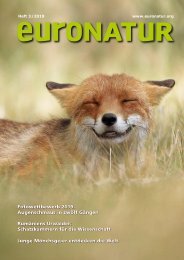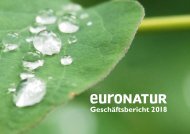Annual Report 2018 EuroNatur Foundation
Here you can get a good overview about our conservation programmes in Europe. Conatains also financial information.
Here you can get a good overview about our conservation programmes in Europe. Conatains also financial information.
You also want an ePaper? Increase the reach of your titles
YUMPU automatically turns print PDFs into web optimized ePapers that Google loves.
Selected <strong>EuroNatur</strong> projects in <strong>2018</strong><br />
European Green Belt Initiative: Many actors – one vision<br />
Geographical location in Europe<br />
Ecosystem network with an extraordinarily high level of<br />
biodiversity, forming a 12,500 km long corridor along the<br />
route of the former Iron Curtain (Map p. 5). The European<br />
Green Belt connects eight biogeographical regions and<br />
24 nations.<br />
Situation<br />
The establishment in 2014 of the European Green Belt<br />
Association e.V. (EGBA) was an important milestone in the<br />
advancement of the European Green Belt Initiative.<br />
Governmental and non-governmental European Green Belt<br />
stakeholders work together in the EGBA, which is chaired<br />
by <strong>EuroNatur</strong>. Conservation activities carried out by the<br />
numerous actors involved are coordinated by four regional<br />
coordinators. <strong>EuroNatur</strong> is the regional coordinator for the<br />
Balkan Green Belt, the European Green Belt’s southernmost<br />
section.<br />
Objectives<br />
Our common aim is to structurally advance and bring substantive<br />
progress to the European Green Belt Initiative, to<br />
gain backing and support in society at large and in the political<br />
sphere for the Green Belt as a pan-European habitat<br />
network, and to highlight the initiative’s contribution to<br />
achieving important international conservation objectives.<br />
Moreover, we hope to establish the Green Belt as a model for<br />
the further development of Green Infrastructure in Europe<br />
and thus as a positive example of maintaining the natural<br />
resource base on which life is built. Transboundary conservation<br />
projects generate exemplary cooperative partnerships.<br />
Selected activities in <strong>2018</strong><br />
In October <strong>2018</strong>, at the 10th Pan-European Green Belt Conference,<br />
more than 100 actors came together from 20 countries<br />
along the European Green Belt. They drew up joint<br />
demands to be put to governments and parliaments regarding<br />
the protection and future development of the Green<br />
Belt, and they agreed the next activities to be undertaken.<br />
Based on comprehensive analyses – primarily of the various<br />
habitat types and existing protected areas – a spatial<br />
delimitation of the Green Belt was developed and officially<br />
adopted by the EGBA.<br />
Once again, the European Green Belt Days were held with a<br />
view to strengthening awareness, encouragement and support<br />
for the European Green Belt. Together with local partners,<br />
<strong>EuroNatur</strong> organized several highly visible activities<br />
along the Balkan Green Belt, including the summiting of the<br />
mountain at the trijunction of Montenegro, Albania and<br />
Kosovo. More than 50 people from five countries thus highlighted<br />
the transboundary conservation efforts in the Balkans.<br />
Selected achievements in <strong>2018</strong><br />
The delimitation of areas considered to be part of the<br />
European Green Belt provides a valuable basis for arguments<br />
to support their protection in discussions with decision-makers.<br />
For example, it has for the first time made<br />
possible analyses of the significance of the Green Belt for<br />
the European Green Infrastructure.<br />
The “European Green Belt Days” have become well established<br />
and now significantly contribute to the European<br />
Green Belt Initiative’s visibility.<br />
Outlook<br />
We endeavour to further boost the European Green Belt<br />
Initiative’s significance at the EU level and, in particular,<br />
to more intensively promote the initiative vis-à-vis the EU<br />
Commission as a model for Green Infrastructure in Europe.<br />
The European Green Belt Days will again be held in 2019<br />
with a view to raising the initiative’s profile.<br />
Partners: BUND, IUCN and all<br />
stakeholders at the European Green Belt<br />
Funding: BfN with funds provided by BMUB,<br />
DBU, <strong>EuroNatur</strong>’s donors<br />
7 <strong>Annual</strong> <strong>Report</strong> <strong>2018</strong><br />
European Green Belt





